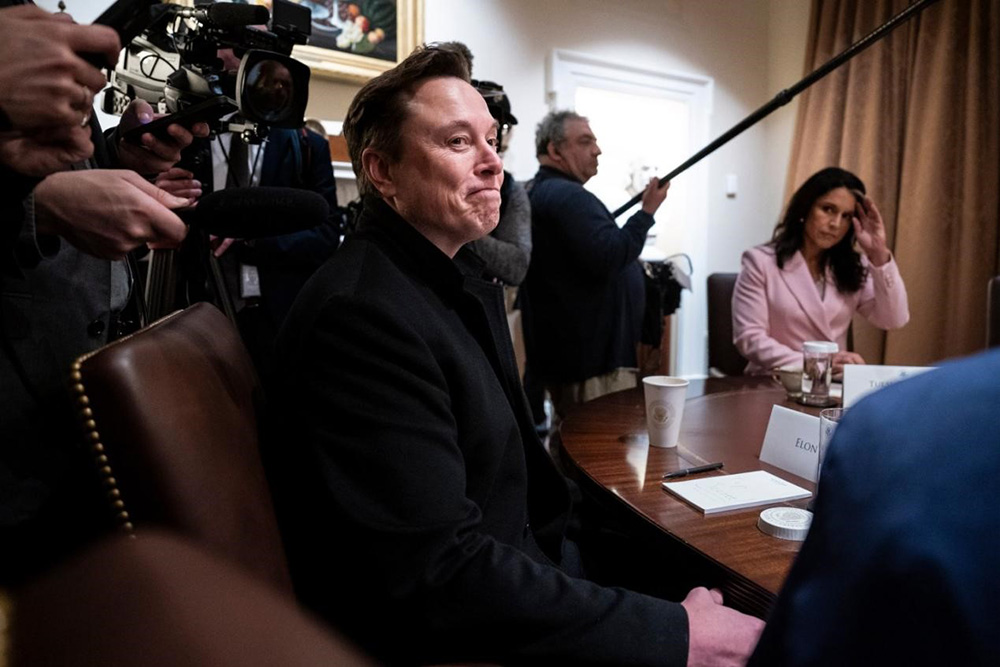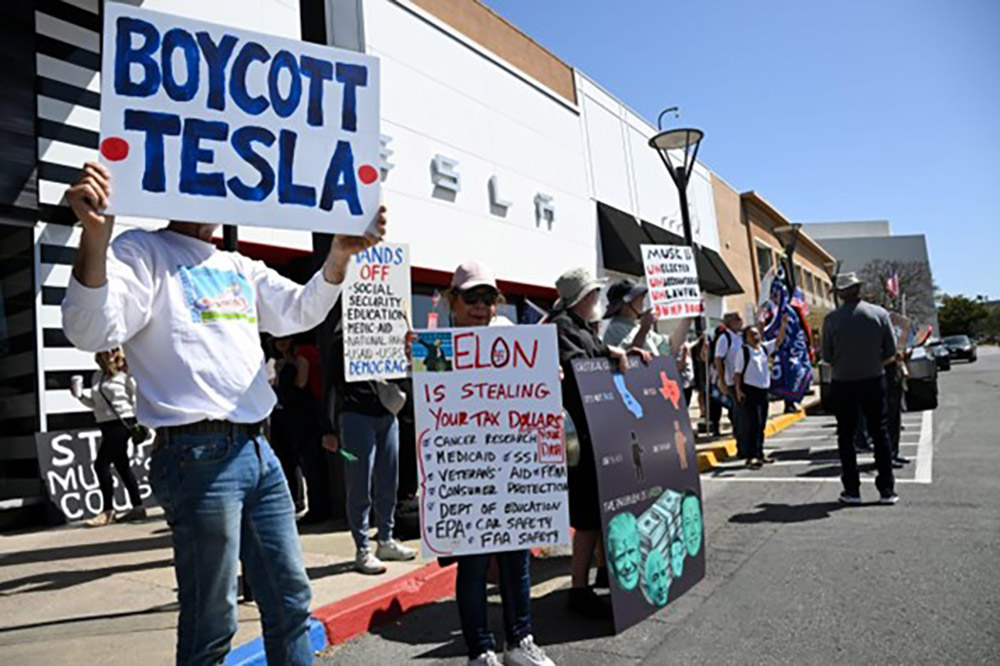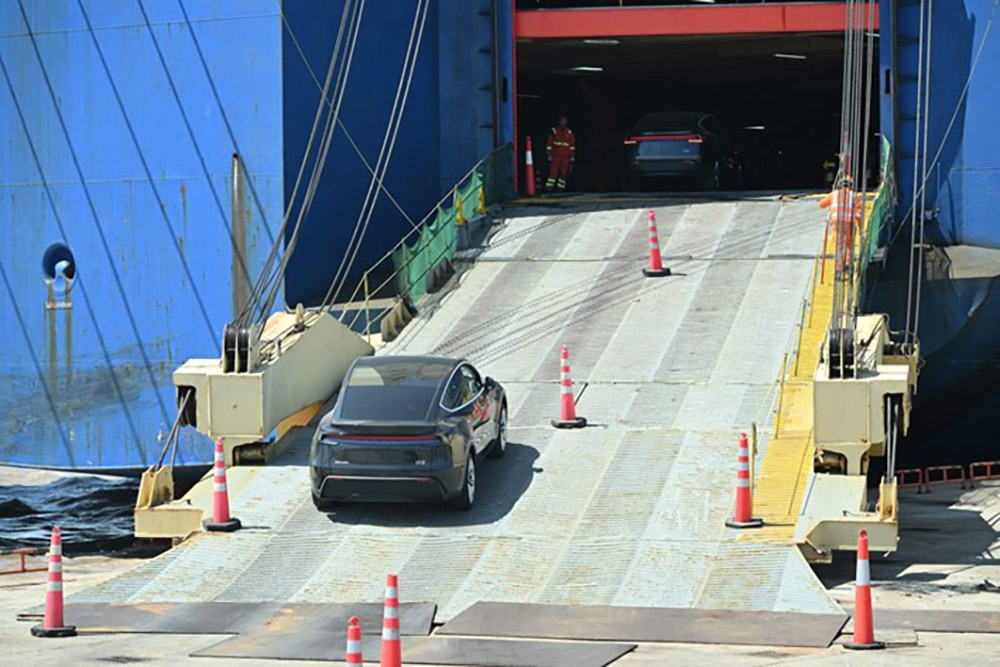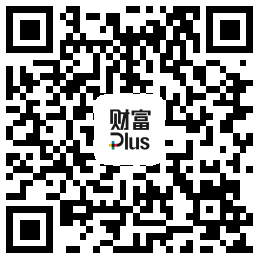
對(duì)特斯拉而言,,這本應(yīng)是意義非凡的一年,,埃隆?馬斯克一直對(duì)此深信不疑,。
1月底公司的財(cái)報(bào)電話會(huì)議上,馬斯克向投資者宣布,,2025年注定會(huì)成為“特斯拉歷史上最重要一年”,。他堅(jiān)稱,,特斯拉將于6月在奧斯汀推出付費(fèi)的Robotaxi服務(wù),與Waymo展開(kāi)競(jìng)爭(zhēng),,而且年底前將拓展到其他城市,。他還設(shè)定了制造1萬(wàn)臺(tái)Optimus人形機(jī)器人的內(nèi)部目標(biāo),。高管們預(yù)計(jì),特斯拉半掛卡車的首款車型今年年底前就能推出,。
然而才過(guò)了三個(gè)月,,一切都走向失控,。
特朗普政府對(duì)中國(guó)進(jìn)口商品大幅加征高達(dá)145%的關(guān)稅,預(yù)計(jì)將影響特斯拉在美國(guó)生產(chǎn)的四分之一汽車,,還會(huì)進(jìn)一步削弱特斯拉在這一關(guān)鍵市場(chǎng)的地位,。與此同時(shí),,中國(guó)電動(dòng)汽車競(jìng)爭(zhēng)對(duì)手比亞迪憑借更高性價(jià)比的車型,在亞洲市場(chǎng)持續(xù)搶占份額,,逐漸動(dòng)搖特斯拉的區(qū)域優(yōu)勢(shì),。3月美國(guó)國(guó)家公路交通安全管理局(NHTSA)勒令特斯拉召回幾乎所有豪華卡車Cybertruck,。此外,本季度特斯拉汽車銷量再次下滑,低于公司預(yù)期,。
馬斯克身為特朗普的“特別政府雇員”,,不僅分散了對(duì)特斯拉的超級(jí)工廠的注意力,陷入華盛頓特區(qū)的官僚事務(wù)中,,馬斯克個(gè)人品牌也就此與特朗普捆綁。所以才會(huì)出現(xiàn)特斯拉汽車遭人蓄意破壞,,美國(guó)各地展廳外抗議活動(dòng)不斷,;特斯拉與歐洲大量客戶群體關(guān)系受損,;以及在中國(guó)這一制造和銷售車輛關(guān)鍵市場(chǎng)的前景遭受質(zhì)疑,。
“跟上次在電話會(huì)議上聽(tīng)到馬斯克發(fā)言時(shí)相比,,如今情勢(shì)已大不相同,,” 長(zhǎng)期以來(lái)一直看好特斯拉的分析師丹?艾夫斯在一次采訪中說(shuō)道,過(guò)去一個(gè)月里他對(duì)該公司的研究報(bào)告愈發(fā)悲觀,。艾夫斯估計(jì),,由于 “自身引發(fā)的品牌問(wèn)題”,,特斯拉在全球已流失至少10%潛在客戶,甚至可能有20%或更多,。
從某些方面來(lái)看,,特斯拉在應(yīng)對(duì)關(guān)稅戰(zhàn)方面比底特律的同行更具優(yōu)勢(shì),。通用汽車(General Motors)和福特汽車(Ford Motor)受中國(guó)市場(chǎng)的影響程度要比特斯拉大得多。與此同時(shí),,特斯拉的股價(jià)從2020年首次實(shí)現(xiàn)盈利以來(lái)就超過(guò)了同行,,目前其股價(jià)更多是看馬斯克對(duì)特斯拉人工智能和自動(dòng)駕駛能力的宏偉構(gòu)想,而不是看基本面,。
分析師們認(rèn)為,特斯拉股價(jià)跟公司業(yè)績(jī)已不再直接掛鉤,?!霸谖覀兛磥?lái),特斯拉股價(jià)已與公司基本面徹底脫節(jié),,”今年早些時(shí)候摩根大通分析師(J.P. Morgan)瑞安·布林克曼在一份報(bào)告中指出,。
然而由于馬斯克被白宮事務(wù)分散精力,且白宮關(guān)稅政策對(duì)他最重要的業(yè)務(wù)造成巨大壓力,,特斯拉嚴(yán)格遵守公開(kāi)設(shè)定的時(shí)間節(jié)點(diǎn)就變得至關(guān)重要。隨著特斯拉股東逐漸失去耐心,,馬斯克比以往更需要重獲信任并激發(fā)信心,。在最新財(cái)報(bào)電話會(huì)議上他將有機(jī)會(huì)做到,這是關(guān)稅政策實(shí)施以來(lái)第一次,。但做起來(lái)困難重重,。
解放日
盡管特朗普的關(guān)稅政策設(shè)定了90天緩沖期,,不確定性還是籠罩市場(chǎng)。而且,,針對(duì)汽車行業(yè)的關(guān)稅仍在且影響不小:4月3日起美國(guó)對(duì)所有進(jìn)口整車加征25%關(guān)稅,。還有其他一些重要的關(guān)稅措施,比如對(duì)全球汽車零部件征收25%關(guān)稅,,以及對(duì)從中國(guó)進(jìn)口電池或稀土征收125%至245%的關(guān)稅,,都可能引發(fā)行業(yè)巨震,。

關(guān)稅政策影響下,標(biāo)普全球汽車(S&P Global Mobility)預(yù)測(cè)美國(guó)汽車年銷量將減少70萬(wàn)輛,,這一單月預(yù)測(cè)降幅創(chuàng)下歷史紀(jì)錄,。特斯拉已受到?jīng)_擊,。中國(guó)對(duì)進(jìn)口汽車加征125%報(bào)復(fù)性關(guān)稅后,特斯拉立即暫停了中國(guó)市場(chǎng)上Model S和Model X的訂單,。另有消息稱,,由于關(guān)稅成本過(guò)高,,特斯拉已停止向美國(guó)運(yùn)送部分Cybertruck和半掛卡車的零部件。
不過(guò)總體而言,,特斯拉受關(guān)稅沖擊可能比競(jìng)爭(zhēng)對(duì)手更小,,因?yàn)槠浯蟛糠周囆投荚诿绹?guó)本土制造,。雖然需要進(jìn)口鋼材和鋁等材料,但整車制造都在美國(guó)超級(jí)工廠完成,。
“特斯拉就像破敗街區(qū)里最體面的房子,,雖然處境稍好,美國(guó)制造的特斯拉汽車中仍有20%至25%會(huì)受到關(guān)稅影響,,”艾夫斯說(shuō),。
上周二財(cái)報(bào)電話會(huì)議上,,特斯拉公布2025年一季度營(yíng)收為193.35億美元,凈利潤(rùn)為4.09億美元,,而去年同期營(yíng)收213億美元,凈收入11億美元,。
“我們認(rèn)為,,特斯拉的市場(chǎng)情緒可能因利好因素迅速扭轉(zhuǎn),未來(lái)幾個(gè)月恰恰是利好消息密集釋放期,,”4月早些時(shí)候美國(guó)投行Piper Sandler分析師亞歷山大·波特在研報(bào)中指出。
Robotaxi為何如此關(guān)鍵
對(duì)于看漲特斯拉的人來(lái)說(shuō),,現(xiàn)在只有一個(gè)問(wèn)題至關(guān)重要,,即自動(dòng)駕駛技術(shù),。
眼下最受關(guān)注的創(chuàng)新就是自動(dòng)駕駛。人們普遍認(rèn)為,只要特斯拉能在面向大眾市場(chǎng)的自動(dòng)駕駛技術(shù)競(jìng)賽中勝出,,那么公司面臨的其他困境或是馬斯克的種種出格言行,,都將無(wú)關(guān)緊要,。
不出所料,馬斯克又夸下???。他聲稱,特斯拉將于2026年量產(chǎn)無(wú)方向盤和踏板的Robotaxi,,最終實(shí)現(xiàn)年產(chǎn)量200萬(wàn)輛的目標(biāo)。他還承諾,,今年6月就將在奧斯汀率先推出付費(fèi)Robotaxi服務(wù),。
“目前來(lái)看,,這可能是最關(guān)鍵的事,”艾夫斯說(shuō),,“該項(xiàng)目將開(kāi)啟特斯拉未來(lái)愿景的重要篇章,。所以我認(rèn)為確保如期推進(jìn)也極其重要,。”

特斯拉自動(dòng)駕駛技術(shù)實(shí)際推進(jìn)進(jìn)度尚不清楚,。去年10月下旬,馬斯克曾表示特斯拉在舊金山灣區(qū)為員工提供配備安全員的自動(dòng)駕駛測(cè)試服務(wù),。不過(guò),《財(cái)富》雜志通過(guò)《信息自由法》(Freedom of Information Act)獲取的特斯拉工程師發(fā)給奧斯汀消防局的郵件顯示,,截至去年11月特斯拉似乎尚未在美國(guó)任何公共道路上測(cè)試自動(dòng)駕駛功能,。
“我們還沒(méi)有在任何公共道路上測(cè)試自動(dòng)駕駛車輛,,”去年11月,特斯拉一位工程師發(fā)給奧斯汀消防局的郵件中談及即將推出新技術(shù)的細(xì)節(jié)時(shí)表示,。特斯拉確實(shí)讓Robotaxi在奧斯汀超級(jí)工廠周圍行駛,,“但都是用于研發(fā)的原型車,,目前不會(huì)在公共道路上行駛,,”她說(shuō)。
特斯拉在公共道路上的測(cè)試都涉及所謂的L2級(jí)智駕,,意思是雖然由系統(tǒng)控制駕駛和剎車,,人類仍需坐在方向盤后且始終保持高度專注。相比之下,,特斯拉主要競(jìng)爭(zhēng)對(duì)手Waymo已在美國(guó)多個(gè)城市每周提供20萬(wàn)次L4級(jí)自動(dòng)駕駛的付費(fèi)出行服務(wù),L4級(jí)智駕已不需要人類駕駛員參與,。而且,,今年早些時(shí)候Waymo專門在奧斯汀為客戶開(kāi)放了等候名單,特斯拉在計(jì)劃推出服務(wù)的首個(gè)城市就已遠(yuǎn)遠(yuǎn)落后,。
不過(guò),特斯拉若想后來(lái)居上還有一個(gè)秘密武器,,那就是數(shù)據(jù),。
總部位于倫敦,專門為自動(dòng)駕駛研發(fā)人工智能軟件的Wayve聯(lián)合創(chuàng)始人兼首席執(zhí)行官亞歷克斯·肯德?tīng)柋硎?,?shù)據(jù)是開(kāi)發(fā)高效自動(dòng)駕駛軟件的關(guān)鍵因素。Wayve正聯(lián)合多家車企和車隊(duì)運(yùn)營(yíng)商將數(shù)據(jù)整合至統(tǒng)一平臺(tái),,以抗衡特斯拉的數(shù)據(jù)優(yōu)勢(shì),。肯德?tīng)栒f(shuō),,特斯拉在全球車企中不僅擁有最龐大的真實(shí)行駛數(shù)據(jù),,數(shù)據(jù)多樣性也遠(yuǎn)超其他自動(dòng)駕駛競(jìng)爭(zhēng)對(duì)手,。早期的自動(dòng)駕駛公司,,如Waymo和已倒閉的Cruise都只在少數(shù)受控環(huán)境中測(cè)試車輛,。掌握數(shù)據(jù)非常重要,,因?yàn)閿?shù)據(jù)的規(guī)模和多樣性決定了公司能否開(kāi)發(fā)出適應(yīng)復(fù)雜路況和天氣的人工智能自駕系統(tǒng)。
數(shù)據(jù)規(guī)模和多樣性對(duì)于現(xiàn)“極端案例”也很關(guān)鍵,,比如消防車堵路,,自行車騎手摔倒在車道等罕見(jiàn)場(chǎng)景,,往往是自動(dòng)駕駛系統(tǒng)最難應(yīng)對(duì)的挑戰(zhàn)。更豐富的真實(shí)路況數(shù)據(jù)能幫助企業(yè)開(kāi)發(fā)更精準(zhǔn)的模擬系統(tǒng),,生成大量合成模擬數(shù)據(jù)或計(jì)算機(jī)數(shù)據(jù),從而進(jìn)一步優(yōu)化自動(dòng)駕駛軟件,。
然而肯德?tīng)栔赋?,打造成功的自?dòng)駕駛系統(tǒng)絕非擁有龐大多樣的數(shù)據(jù)就能實(shí)現(xiàn)?!拔业故窍M斎霐?shù)據(jù)就實(shí)現(xiàn)自動(dòng)駕駛,”他說(shuō),,“實(shí)際上還有很多因素要考慮,?!?/p>
在其他方面,,特斯拉的優(yōu)勢(shì)可能并不明顯??系?tīng)柵e例稱,,更龐大更多樣的駕駛數(shù)據(jù)集確實(shí)能涵蓋更多極端案例,但如何從海量數(shù)據(jù)中精準(zhǔn)識(shí)別出案例在技術(shù)上頗具難度,。開(kāi)發(fā)出優(yōu)秀的模擬系統(tǒng),,精準(zhǔn)設(shè)計(jì)模擬場(chǎng)景以補(bǔ)充現(xiàn)實(shí)數(shù)據(jù),,同樣是重要的競(jìng)爭(zhēng)壁壘。而且,,為人工智能打造最佳"學(xué)習(xí)算法",,幫助其掌握駕駛技能也很關(guān)鍵。這些需要頂尖的人工智能研究人員和工程師,,還要有充足的計(jì)算能力訓(xùn)練頂級(jí)人工智能模型,??系?tīng)栒J(rèn)為,特斯拉或許具備部分條件,,但尚未證明能將優(yōu)勢(shì)有效整合,。
特斯拉的自動(dòng)駕駛系統(tǒng)最終與競(jìng)爭(zhēng)對(duì)手相比如何,,以及能否趕在承諾的6月奧斯汀服務(wù)上線前取得突破,將決定該公司能否順利度過(guò)眼下的艱難之年,。
“如果6月拖到8月,8月拖到10月,,那可就糟透了,,”艾夫斯說(shuō)。(財(cái)富中文網(wǎng))
譯者:梁宇
審校:夏林
對(duì)特斯拉而言,,這本應(yīng)是意義非凡的一年,,埃隆?馬斯克一直對(duì)此深信不疑,。
1月底公司的財(cái)報(bào)電話會(huì)議上,馬斯克向投資者宣布,,2025年注定會(huì)成為“特斯拉歷史上最重要一年”,。他堅(jiān)稱,特斯拉將于6月在奧斯汀推出付費(fèi)的Robotaxi服務(wù),,與Waymo展開(kāi)競(jìng)爭(zhēng),,而且年底前將拓展到其他城市,。他還設(shè)定了制造1萬(wàn)臺(tái)Optimus人形機(jī)器人的內(nèi)部目標(biāo)。高管們預(yù)計(jì),,特斯拉半掛卡車的首款車型今年年底前就能推出,。
然而才過(guò)了三個(gè)月,一切都走向失控,。
特朗普政府對(duì)中國(guó)進(jìn)口商品大幅加征高達(dá)145%的關(guān)稅,,預(yù)計(jì)將影響特斯拉在美國(guó)生產(chǎn)的四分之一汽車,還會(huì)進(jìn)一步削弱特斯拉在這一關(guān)鍵市場(chǎng)的地位,。與此同時(shí),,中國(guó)電動(dòng)汽車競(jìng)爭(zhēng)對(duì)手比亞迪憑借更高性價(jià)比的車型,在亞洲市場(chǎng)持續(xù)搶占份額,,逐漸動(dòng)搖特斯拉的區(qū)域優(yōu)勢(shì),。3月美國(guó)國(guó)家公路交通安全管理局(NHTSA)勒令特斯拉召回幾乎所有豪華卡車Cybertruck。此外,,本季度特斯拉汽車銷量再次下滑,低于公司預(yù)期,。
馬斯克身為特朗普的“特別政府雇員”,,不僅分散了對(duì)特斯拉的超級(jí)工廠的注意力,,陷入華盛頓特區(qū)的官僚事務(wù)中,馬斯克個(gè)人品牌也就此與特朗普捆綁,。所以才會(huì)出現(xiàn)特斯拉汽車遭人蓄意破壞,,美國(guó)各地展廳外抗議活動(dòng)不斷;特斯拉與歐洲大量客戶群體關(guān)系受損,;以及在中國(guó)這一制造和銷售車輛關(guān)鍵市場(chǎng)的前景遭受質(zhì)疑,。
“跟上次在電話會(huì)議上聽(tīng)到馬斯克發(fā)言時(shí)相比,如今情勢(shì)已大不相同,,” 長(zhǎng)期以來(lái)一直看好特斯拉的分析師丹?艾夫斯在一次采訪中說(shuō)道,,過(guò)去一個(gè)月里他對(duì)該公司的研究報(bào)告愈發(fā)悲觀。艾夫斯估計(jì),,由于 “自身引發(fā)的品牌問(wèn)題”,,特斯拉在全球已流失至少10%潛在客戶,甚至可能有20%或更多,。
從某些方面來(lái)看,,特斯拉在應(yīng)對(duì)關(guān)稅戰(zhàn)方面比底特律的同行更具優(yōu)勢(shì)。通用汽車(General Motors)和福特汽車(Ford Motor)受中國(guó)市場(chǎng)的影響程度要比特斯拉大得多,。與此同時(shí),,特斯拉的股價(jià)從2020年首次實(shí)現(xiàn)盈利以來(lái)就超過(guò)了同行,目前其股價(jià)更多是看馬斯克對(duì)特斯拉人工智能和自動(dòng)駕駛能力的宏偉構(gòu)想,,而不是看基本面,。
分析師們認(rèn)為,特斯拉股價(jià)跟公司業(yè)績(jī)已不再直接掛鉤,?!霸谖覀兛磥?lái),特斯拉股價(jià)已與公司基本面徹底脫節(jié),,”今年早些時(shí)候摩根大通分析師(J.P. Morgan)瑞安·布林克曼在一份報(bào)告中指出,。
然而由于馬斯克被白宮事務(wù)分散精力,且白宮關(guān)稅政策對(duì)他最重要的業(yè)務(wù)造成巨大壓力,,特斯拉嚴(yán)格遵守公開(kāi)設(shè)定的時(shí)間節(jié)點(diǎn)就變得至關(guān)重要,。隨著特斯拉股東逐漸失去耐心,馬斯克比以往更需要重獲信任并激發(fā)信心,。在最新財(cái)報(bào)電話會(huì)議上他將有機(jī)會(huì)做到,,這是關(guān)稅政策實(shí)施以來(lái)第一次。但做起來(lái)困難重重,。
解放日
盡管特朗普的關(guān)稅政策設(shè)定了90天緩沖期,,不確定性還是籠罩市場(chǎng)。而且,,針對(duì)汽車行業(yè)的關(guān)稅仍在且影響不?。?月3日起美國(guó)對(duì)所有進(jìn)口整車加征25%關(guān)稅,。還有其他一些重要的關(guān)稅措施,比如對(duì)全球汽車零部件征收25%關(guān)稅,,以及對(duì)從中國(guó)進(jìn)口電池或稀土征收125%至245%的關(guān)稅,,都可能引發(fā)行業(yè)巨震。
關(guān)稅政策影響下,,標(biāo)普全球汽車(S&P Global Mobility)預(yù)測(cè)美國(guó)汽車年銷量將減少70萬(wàn)輛,,這一單月預(yù)測(cè)降幅創(chuàng)下歷史紀(jì)錄。特斯拉已受到?jīng)_擊,。中國(guó)對(duì)進(jìn)口汽車加征125%報(bào)復(fù)性關(guān)稅后,,特斯拉立即暫停了中國(guó)市場(chǎng)上Model S和Model X的訂單。另有消息稱,,由于關(guān)稅成本過(guò)高,,特斯拉已停止向美國(guó)運(yùn)送部分Cybertruck和半掛卡車的零部件。
不過(guò)總體而言,,特斯拉受關(guān)稅沖擊可能比競(jìng)爭(zhēng)對(duì)手更小,,因?yàn)槠浯蟛糠周囆投荚诿绹?guó)本土制造。雖然需要進(jìn)口鋼材和鋁等材料,,但整車制造都在美國(guó)超級(jí)工廠完成,。
“特斯拉就像破敗街區(qū)里最體面的房子,雖然處境稍好,,美國(guó)制造的特斯拉汽車中仍有20%至25%會(huì)受到關(guān)稅影響,,”艾夫斯說(shuō)。
上周二財(cái)報(bào)電話會(huì)議上,,特斯拉公布2025年一季度營(yíng)收為193.35億美元,,凈利潤(rùn)為4.09億美元,而去年同期營(yíng)收213億美元,,凈收入11億美元,。
“我們認(rèn)為,特斯拉的市場(chǎng)情緒可能因利好因素迅速扭轉(zhuǎn),,未來(lái)幾個(gè)月恰恰是利好消息密集釋放期,,”4月早些時(shí)候美國(guó)投行Piper Sandler分析師亞歷山大·波特在研報(bào)中指出。
Robotaxi為何如此關(guān)鍵
對(duì)于看漲特斯拉的人來(lái)說(shuō),,現(xiàn)在只有一個(gè)問(wèn)題至關(guān)重要,,即自動(dòng)駕駛技術(shù)。
眼下最受關(guān)注的創(chuàng)新就是自動(dòng)駕駛,。人們普遍認(rèn)為,,只要特斯拉能在面向大眾市場(chǎng)的自動(dòng)駕駛技術(shù)競(jìng)賽中勝出,那么公司面臨的其他困境或是馬斯克的種種出格言行,都將無(wú)關(guān)緊要,。
不出所料,,馬斯克又夸下???。他聲稱,特斯拉將于2026年量產(chǎn)無(wú)方向盤和踏板的Robotaxi,,最終實(shí)現(xiàn)年產(chǎn)量200萬(wàn)輛的目標(biāo),。他還承諾,今年6月就將在奧斯汀率先推出付費(fèi)Robotaxi服務(wù),。
“目前來(lái)看,,這可能是最關(guān)鍵的事,”艾夫斯說(shuō),,“該項(xiàng)目將開(kāi)啟特斯拉未來(lái)愿景的重要篇章,。所以我認(rèn)為確保如期推進(jìn)也極其重要?!?/p>
特斯拉自動(dòng)駕駛技術(shù)實(shí)際推進(jìn)進(jìn)度尚不清楚,。去年10月下旬,馬斯克曾表示特斯拉在舊金山灣區(qū)為員工提供配備安全員的自動(dòng)駕駛測(cè)試服務(wù),。不過(guò),,《財(cái)富》雜志通過(guò)《信息自由法》(Freedom of Information Act)獲取的特斯拉工程師發(fā)給奧斯汀消防局的郵件顯示,截至去年11月特斯拉似乎尚未在美國(guó)任何公共道路上測(cè)試自動(dòng)駕駛功能,。
“我們還沒(méi)有在任何公共道路上測(cè)試自動(dòng)駕駛車輛,,”去年11月,特斯拉一位工程師發(fā)給奧斯汀消防局的郵件中談及即將推出新技術(shù)的細(xì)節(jié)時(shí)表示,。特斯拉確實(shí)讓Robotaxi在奧斯汀超級(jí)工廠周圍行駛,,“但都是用于研發(fā)的原型車,目前不會(huì)在公共道路上行駛,,”她說(shuō),。
特斯拉在公共道路上的測(cè)試都涉及所謂的L2級(jí)智駕,意思是雖然由系統(tǒng)控制駕駛和剎車,,人類仍需坐在方向盤后且始終保持高度專注,。相比之下,特斯拉主要競(jìng)爭(zhēng)對(duì)手Waymo已在美國(guó)多個(gè)城市每周提供20萬(wàn)次L4級(jí)自動(dòng)駕駛的付費(fèi)出行服務(wù),,L4級(jí)智駕已不需要人類駕駛員參與,。而且,今年早些時(shí)候Waymo專門在奧斯汀為客戶開(kāi)放了等候名單,,特斯拉在計(jì)劃推出服務(wù)的首個(gè)城市就已遠(yuǎn)遠(yuǎn)落后,。
不過(guò),特斯拉若想后來(lái)居上還有一個(gè)秘密武器,那就是數(shù)據(jù),。
總部位于倫敦,,專門為自動(dòng)駕駛研發(fā)人工智能軟件的Wayve聯(lián)合創(chuàng)始人兼首席執(zhí)行官亞歷克斯·肯德?tīng)柋硎荆瑪?shù)據(jù)是開(kāi)發(fā)高效自動(dòng)駕駛軟件的關(guān)鍵因素,。Wayve正聯(lián)合多家車企和車隊(duì)運(yùn)營(yíng)商將數(shù)據(jù)整合至統(tǒng)一平臺(tái),,以抗衡特斯拉的數(shù)據(jù)優(yōu)勢(shì)??系?tīng)栒f(shuō),,特斯拉在全球車企中不僅擁有最龐大的真實(shí)行駛數(shù)據(jù),數(shù)據(jù)多樣性也遠(yuǎn)超其他自動(dòng)駕駛競(jìng)爭(zhēng)對(duì)手,。早期的自動(dòng)駕駛公司,,如Waymo和已倒閉的Cruise都只在少數(shù)受控環(huán)境中測(cè)試車輛。掌握數(shù)據(jù)非常重要,,因?yàn)閿?shù)據(jù)的規(guī)模和多樣性決定了公司能否開(kāi)發(fā)出適應(yīng)復(fù)雜路況和天氣的人工智能自駕系統(tǒng),。
數(shù)據(jù)規(guī)模和多樣性對(duì)于現(xiàn)“極端案例”也很關(guān)鍵,比如消防車堵路,,自行車騎手摔倒在車道等罕見(jiàn)場(chǎng)景,,往往是自動(dòng)駕駛系統(tǒng)最難應(yīng)對(duì)的挑戰(zhàn)。更豐富的真實(shí)路況數(shù)據(jù)能幫助企業(yè)開(kāi)發(fā)更精準(zhǔn)的模擬系統(tǒng),,生成大量合成模擬數(shù)據(jù)或計(jì)算機(jī)數(shù)據(jù),,從而進(jìn)一步優(yōu)化自動(dòng)駕駛軟件。
然而肯德?tīng)栔赋?,打造成功的自?dòng)駕駛系統(tǒng)絕非擁有龐大多樣的數(shù)據(jù)就能實(shí)現(xiàn),。“我倒是希望輸入數(shù)據(jù)就實(shí)現(xiàn)自動(dòng)駕駛,,”他說(shuō),,“實(shí)際上還有很多因素要考慮?!?/p>
在其他方面,,特斯拉的優(yōu)勢(shì)可能并不明顯??系?tīng)柵e例稱,,更龐大更多樣的駕駛數(shù)據(jù)集確實(shí)能涵蓋更多極端案例,但如何從海量數(shù)據(jù)中精準(zhǔn)識(shí)別出案例在技術(shù)上頗具難度,。開(kāi)發(fā)出優(yōu)秀的模擬系統(tǒng),,精準(zhǔn)設(shè)計(jì)模擬場(chǎng)景以補(bǔ)充現(xiàn)實(shí)數(shù)據(jù),同樣是重要的競(jìng)爭(zhēng)壁壘,。而且,,為人工智能打造最佳"學(xué)習(xí)算法",幫助其掌握駕駛技能也很關(guān)鍵,。這些需要頂尖的人工智能研究人員和工程師,還要有充足的計(jì)算能力訓(xùn)練頂級(jí)人工智能模型,??系?tīng)栒J(rèn)為,特斯拉或許具備部分條件,,但尚未證明能將優(yōu)勢(shì)有效整合,。
特斯拉的自動(dòng)駕駛系統(tǒng)最終與競(jìng)爭(zhēng)對(duì)手相比如何,,以及能否趕在承諾的6月奧斯汀服務(wù)上線前取得突破,,將決定該公司能否順利度過(guò)眼下的艱難之年。
“如果6月拖到8月,,8月拖到10月,,那可就糟透了,”艾夫斯說(shuō),。(財(cái)富中文網(wǎng))
譯者:梁宇
審校:夏林
This was supposed to be an extraordinary year for Tesla—Elon Musk had insisted on it.
2025 was set to be “the biggest year in Tesla history,” Musk pronounced to investors at the end of January on the company’s earnings call. He maintained that Tesla would launch its paid robotaxi service in Austin in June to compete against Waymo, and that the EV maker would be rolling out the service to other cities before this year is up. He set an internal target to build 10,000 Optimus humanoid robots. And executives projected they will have the first builds of Tesla’s semitruck design out before the end of this year.
And yet—just three months later—everything is spiraling.
The Trump administration’s titanic 145% tariffs on Chinese imports are expected to hit a quarter of the vehicles Tesla manufactures in the U.S.—and further tarnish Tesla’s position in one of its most important markets. Chinese EV rival BYD has continued to lap up market share in Asia with its more affordable vehicle, eroding Tesla’s leading position in the region. The national highway safety regulator, NHTSA, recalled nearly all of Tesla’s luxury trucks, the Cybertruck, in March. And Tesla’s vehicle sales dropped again this quarter, below the company’s own projections.
Musk’s status as Trump’s “special government employee” has not only pulled his attention away from Tesla’s gigafactories and into D.C.’s bureaucracy—but it has also intertwined Musk’s brand with Trump’s. That has already led to vandalism of Tesla cars and protests outside U.S. showrooms; a damaged relationship with a big chunk of its customer base in Europe; and serious questions around the company’s prospects in China, a critical market for the manufacturing and sale of its vehicles.
“It’s a different world than the last time we heard from Musk on the conference call,” Dan Ives, one of Tesla’s longest-standing bullish analysts whose research notes on the company have become increasingly dire over the past month, said in an interview. Ives has estimated that Tesla has lost at least 10%—but maybe even 20% or higher—of its future customer base globally, because of “self-created brand issues.”
Tesla, in some ways, is diving into the tariff craze better positioned than its Detroit-based peers. General Motors and Ford have much more exposure to China than Tesla does. At the same time, Tesla’s stock price—which has soared above peers’ since its first profitable year in 2020—is not so tied to fundamentals as it is to the grand vision Musk has presented around Tesla’s artificial intelligence and self-driving capabilities.
Analysts have opined that the stock performance doesn’t directly correlate with the company’s financial performance anymore. “Tesla shares continue to strike us as having become completely divorced from the fundamentals,” J.P. Morgan analyst Ryan Brinkman opined in a note earlier this year.
But with Musk distracted in the White House, and the White House tariff policy putting incredible pressure on his most important business, it will be critical for Tesla to adhere to the timelines it has publicly set. And with Tesla shareholders losing patience, Musk, more than ever, needs to regain trust and inspire confidence—something he will have a chance to do for the first time since the tariffs during the company’s quarterly earnings call on Tuesday. None of it will be easy.
Liberation Day
Uncertainty surrounding Trump’s tariff scheme has roiled the markets, even after a 90-day pause was rolled out. But the tariffs on the auto industry are still alive and well: A duty of 25% was set, effective April 3, on all vehicles imported into the U.S. fully built. Other key tariffs, including a 25% one on global auto parts and a 125% to 245% tariff on Chinese imports of batteries or rare earths, could roil the industry.
The tariffs have led S&P Global Mobility to reduce its annual U.S. automobile sales estimate by 700,000 cars, one of the largest single-month changes to its forecast ever. And they are already taking a toll on Tesla. After China levied its own retaliatory tariffs, charging 125% import duties on vehicles imported into the country, Tesla stopped taking orders from Chinese customers for its Model S and Model X. Tesla has also reportedly stopped shipping some parts for its Cybertrucks and Semi into the U.S., because the tariffs have gotten too high.
Overall, however, Tesla may be more immune to the tariffs than its competitors, as it manufactures most of its vehicles in the U.S. While the company imports materials like steel and aluminum, the vehicles are made in U.S. gigafactories.
“They’re the best house in a bad neighborhood, but still, 20% to 25% of U.S.-built Teslas have tariff exposure,” Ives says.
Analysts are forecasting that Tesla will post $21.5 billion in revenue and $1.3 billion in net income on its earnings call this Tuesday—compared with $21.3 billion in revenue and $1.1 billion in net income during the year-ago period. Tesla shares closed at $241.38 on Friday afternoon, down more than 36% from January—but still up more than 64% from this time last year.
“We think TSLA sentiment can change rapidly once catalysts emerge, and the next few months are catalyst-rich,” Alexander Potter, a research analyst at Piper Sandler, wrote earlier this month in a research note.
Why the robo launch is so critical
For some Tesla bulls, there’s only one issue that really matters right now: autonomous driving.
The nearer-term innovation in focus is autonomy—and if Tesla can win the race to develop self-driving car technology for the mass market, the thinking goes, none of the company’s other troubles, or Musk’s antics, will matter so much.
Not surprisingly, Musk has talked up a big game. He has said that Tesla will start volume production of its robotaxi—which will have no steering wheels or pedals—in 2026, and that Tesla will eventually be manufacturing 2 million of them a year. And he has promised that a paid robotaxi service of some kind will debut in Austin in June.
“That right now is probably front and center,” Ives says. “It kicks off a big part of the future vision of Tesla. So I think it’s extremely important to also hit that date, too.”
Exactly where Tesla is in the process of rolling things out, however, is not clear. In late October, Musk said that Tesla was conducting test rides, with safety drivers, for employees in the Bay Area. According to emails from a Tesla engineer to the Austin Fire Department obtained by Fortune via a Freedom of Information Act request, however, as of November, Tesla seemingly still hadn’t tested its autonomous function on public roads anywhere in the U.S.
“We have not done any testing on public roadways with any autonomous vehicles,” the Tesla engineer said in the email to the Austin Fire Department in November, when discussing details about the upcoming launch. Though Tesla did have its robotaxi driving around at its Austin gigafactory, “these are prototype vehicles for developmental purposes only, and are not driving on public roadways at this time,” she said.
All of Tesla’s testing on public roadways has involved so-called Level 2 systems, meaning that, while the system is controlling the driving and braking, humans are behind the steering wheel and remaining fully attentive at all times. By contrast, Waymo, which is Tesla’s main competitor, is already doing 200,000 paid rides every week at Level 4—with no human drivers in the vehicles—across various cities around the U.S. And given that Waymo opened its wait list for customers in Austin earlier this year, Tesla is already far behind its rival in the first city where it plans to launch.
If there’s one secret weapon in Tesla’s arsenal that could help it catch up, however, it’s data.
Alex Kendall, the cofounder and CEO of Wayve, a London-based company building AI software for autonomous driving, says that data is a critical component in building effective self-driving software. Wayve is pursuing the idea of working with multiple carmakers and fleet operators and getting them to combine their data into a single platform to help level the data advantage that Tesla might have. Not only does Tesla almost certainly have more driving data gathered from its cars worldwide than any other automaker, says Kendall, but it also has more diverse data than its self-driving competitors. Earlier generations of self-driving companies, such as Waymo and now-defunct Cruise, deployed their cars in only a few tightly controlled driving environments. This matters because it is the amount and diversity of data that will allow a company to build AI self-driving systems that work well in a wide array of traffic and weather conditions.
The amount and diversity of data also matters for discovering “edge cases”—uncommon or rare occurrences, such as a fire engine blocking a road, or a bicyclist who has fallen into the street—that are the toughest challenges for self-drivig software to successfully navigate. Having more diverse real-world driving data can help companies build better simulators, which in turn allow that company to generate lots more synthetic—or computer-generated—data to further refine their self-driving software.
But all that said, Kendall says there is much more to creating a successful self-driving system than just the magnitude and diversity of data a company has. “I wish it was as simple as data in and driving out,” he said. “But there are so many other aspects to it.”
And when it comes to those other aspects, Tesla may have much less of an advantage. For instance, Kendall said that while larger and more diverse driving datasets will almost certainly contain more edge cases, identifying those edge cases in that sea of data is technically tricky. Building good simulators and deciding exactly what scenarios to simulate to augment the real-world data is also a key differentiator. Finally, building the best “l(fā)earning algorithm” for an AI system to help it master driving is also critically important, and this depends on having brilliant AI researchers and engineers as well as access to enough computing power to train top-of-the-line AI models. Tesla, Kendall says, may have some of these components, but has not yet demonstrated that it can put them all together in the most effective way.
How Tesla’s self-driving systems ultimately stack up to competitors—and whether they do on time, especially with the promised Austin June launch approaching—will be critical as the company navigates what’s been a very difficult year.
“If June becomes August, and August becomes October, that would be a very, very bad thing,” Ives says.






